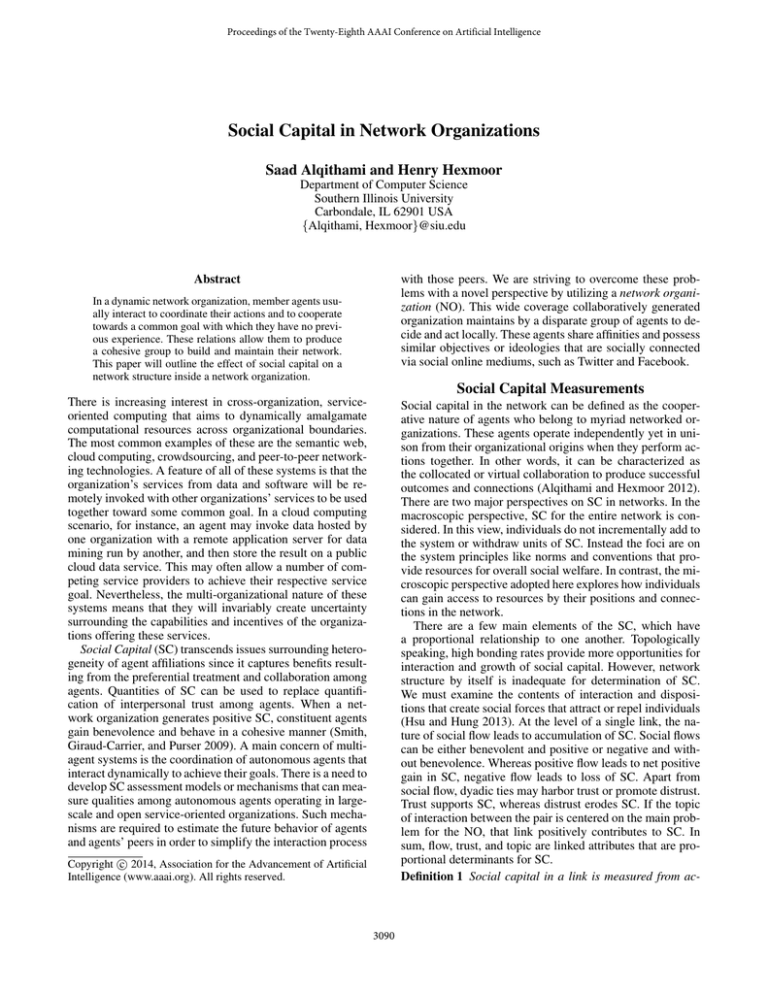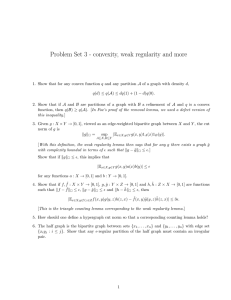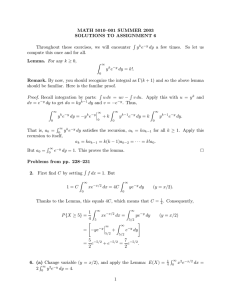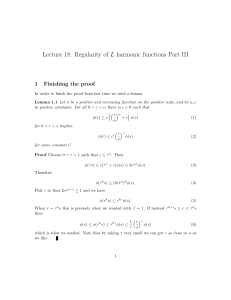
Proceedings of the Twenty-Eighth AAAI Conference on Artificial Intelligence
Social Capital in Network Organizations
Saad Alqithami and Henry Hexmoor
Department of Computer Science
Southern Illinois University
Carbondale, IL 62901 USA
{Alqithami, Hexmoor}@siu.edu
Abstract
with those peers. We are striving to overcome these problems with a novel perspective by utilizing a network organization (NO). This wide coverage collaboratively generated
organization maintains by a disparate group of agents to decide and act locally. These agents share affinities and possess
similar objectives or ideologies that are socially connected
via social online mediums, such as Twitter and Facebook.
In a dynamic network organization, member agents usually interact to coordinate their actions and to cooperate
towards a common goal with which they have no previous experience. These relations allow them to produce
a cohesive group to build and maintain their network.
This paper will outline the effect of social capital on a
network structure inside a network organization.
Social Capital Measurements
There is increasing interest in cross-organization, serviceoriented computing that aims to dynamically amalgamate
computational resources across organizational boundaries.
The most common examples of these are the semantic web,
cloud computing, crowdsourcing, and peer-to-peer networking technologies. A feature of all of these systems is that the
organization’s services from data and software will be remotely invoked with other organizations’ services to be used
together toward some common goal. In a cloud computing
scenario, for instance, an agent may invoke data hosted by
one organization with a remote application server for data
mining run by another, and then store the result on a public
cloud data service. This may often allow a number of competing service providers to achieve their respective service
goal. Nevertheless, the multi-organizational nature of these
systems means that they will invariably create uncertainty
surrounding the capabilities and incentives of the organizations offering these services.
Social Capital (SC) transcends issues surrounding heterogeneity of agent affiliations since it captures benefits resulting from the preferential treatment and collaboration among
agents. Quantities of SC can be used to replace quantification of interpersonal trust among agents. When a network organization generates positive SC, constituent agents
gain benevolence and behave in a cohesive manner (Smith,
Giraud-Carrier, and Purser 2009). A main concern of multiagent systems is the coordination of autonomous agents that
interact dynamically to achieve their goals. There is a need to
develop SC assessment models or mechanisms that can measure qualities among autonomous agents operating in largescale and open service-oriented organizations. Such mechanisms are required to estimate the future behavior of agents
and agents’ peers in order to simplify the interaction process
Social capital in the network can be defined as the cooperative nature of agents who belong to myriad networked organizations. These agents operate independently yet in unison from their organizational origins when they perform actions together. In other words, it can be characterized as
the collocated or virtual collaboration to produce successful
outcomes and connections (Alqithami and Hexmoor 2012).
There are two major perspectives on SC in networks. In the
macroscopic perspective, SC for the entire network is considered. In this view, individuals do not incrementally add to
the system or withdraw units of SC. Instead the foci are on
the system principles like norms and conventions that provide resources for overall social welfare. In contrast, the microscopic perspective adopted here explores how individuals
can gain access to resources by their positions and connections in the network.
There are a few main elements of the SC, which have
a proportional relationship to one another. Topologically
speaking, high bonding rates provide more opportunities for
interaction and growth of social capital. However, network
structure by itself is inadequate for determination of SC.
We must examine the contents of interaction and dispositions that create social forces that attract or repel individuals
(Hsu and Hung 2013). At the level of a single link, the nature of social flow leads to accumulation of SC. Social flows
can be either benevolent and positive or negative and without benevolence. Whereas positive flow leads to net positive
gain in SC, negative flow leads to loss of SC. Apart from
social flow, dyadic ties may harbor trust or promote distrust.
Trust supports SC, whereas distrust erodes SC. If the topic
of interaction between the pair is centered on the main problem for the NO, that link positively contributes to SC. In
sum, flow, trust, and topic are linked attributes that are proportional determinants for SC.
Definition 1 Social capital in a link is measured from ac-
c 2014, Association for the Advancement of Artificial
Copyright Intelligence (www.aaai.org). All rights reserved.
3090
enter bartering anonymously with another node with whom
there may not be a direct link. Next, we turn to a description
of a mechanism for trading. First, we define an independent
value we call commitment level.
Definition 3 Commitment Level (CL) is the degree to which
agents in an NO are willing to work hard to achieve the network objectives. This level is an independent value from the
social capital. For simplicity, we assume a value range of
[0.0 − 1.0].
Definition 4 Contribution of an Agent A toward a task i
with performance P (A, i) is P × CL. This means that
C(i, A) = perf ormance P (A, i) × CL.
Definition 5 Retention rate of the task i by Agent A is
measured by the complement of A’s contribution to task i
(i.e.,R(A, i) = 1.0 − C(i, A)).
When an Agent A’s retention rate for a task i is low, A
may wish to trade a task i with another agent provided the
agent has sufficient social capital. The value of each trade
will depend on the private value assigned by the trading partner. In order to secure a trade, the agent offering to trade
must determine the strategic equilibrium value for agent profiles over tasks, i.e., the trader agent must compute the maximum contribution (MC) any agent can make over any task.
If the social capital value offered is equal or greater than this
MC value, the trade is rational and can be guaranteed.
cumulation of positive values of social flow and trust plus
abundance of communication over the common topic of NO.
At this point, we treat all three attributes equally.
Since considering a topic of interaction is included in the
definition, we note that this formulation of social capital is
relativized for links only in an NO. Next, we focus on determination of social capital in a given network as stated in
Lemma 1.
Lemma 1 The total amount of social capital in the network
is proportional to the sum of social capital in network links.
Social capital is generated in the links through dynamics
of interaction inside the links. Therefore, SC for a network
linearly scales by summing SC for all links in the network.
Increased links are proportional to increased social capital
stated in Lemma 2. The effects of topology are overlooked
in this network perspective but will be considered in the egocentric in the next definition. All bridged communities contribute to accumulation of the overall SC, which is the instrumental purpose of SC. In general networks and from an
egocentric perspective, bridging is said to contribute to social capital (Smith, Giraud-Carrier, and Purser 2009). This
is discussed later in the egocentric view of SC.
Lemma 2 Social capital in the network is proportional to
network bonding measure.
Network bonding leads to increased density and closure in
the network, which is believed to increase resource access.
Lemma 2 is obvious since bonding rate is proportional to the
number of links. According to Lemma 1, the number of links
in the network, i.e., the more interconnections a network has,
the more opportunities it will have for accumulation of SC.
If a network has the most links possible (i.e., a clique) it
would support the highest SC.
Conclusions and Future work
In open environments, such as the environments envisioned
for NO, agents are integrated dynamically across their organizational and geographical boundaries to justify each
other’s needs. Such systems should be modeled as multiagent systems, in which autonomous agents can interact in
an open environment, despite potentially conflicting interests. NOs are commonly subservient to electronic institutions (EI) that make and monitor policies. Water quality and
health quality exchanges are two examples of electronic institutions guiding large subordinate network organizations.
EIs must routinely monitor and improve SC by updating the
organization’s policies. A SC assessment model has been
described to measure relations among autonomous agents
operating in large-scale open service-oriented organizations.
Such mechanisms are required to estimate the future behavior of agents and agents’ peers in order to simplify the interaction process with those peers. The aim in the future is
to further validate and develop SC models and to produce a
method to quantify network organization’s responsiveness.
Theorem 1 A network topology that is a clique produces
the highest social capital.
To this end, we define an egocentric perspective for social
capital.
Definition 2 Social capital for a node (i.e., egocentric for
an individual) is the sum of social capital derived from its
links with direct neighbors plus sum of SC of all its neighbors.
This egocentric definition of SC deliberately mirrors the
Bonacich Power Index (Bonacich 1987). This coincidence
helps us to exploit the topological position of nodes. A node
that is well positioned by having a high power index (i.e.,
high Bonacich centrality value) will similarly possess high
social capital.
References
Alqithami, S., and Hexmoor, H. 2012. Social capital in
virtual organizations. In INCoS, 682–687.
Bonacich, P. 1987. Power and centrality: A family of measures. American Journal of Sociology 92(5):1170–1182.
Hsu, J., and Hung, Y. 2013. Exploring the interaction effects
of social capital. Inf. Manage. 50(7):415–430.
Smith, M.; Giraud-Carrier, C.; and Purser, N. 2009. Implicit affinity networks and social capital. Inf. Technol. and
Management 10(2-3):123–134.
Lemma 3 Nodes in a network with higher power or roles
possess higher social capital.
We consider SC to be a scalar value that can be accumulated as well as consumed either verbatim or used as credit.
In a network, SC might be used to trade for help or exchanges with others in the form of delegation of tasks. Bartering with SC can be limited to a pair of nodes through an
immediate link between them. Alternatively, a node might
3091






